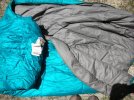- Joined
- Nov 6, 2006
- Messages
- 3,734
Up for grabs is a 1998 vintage Mountain Hardwear 1st Dimension sleeping bag. Don't let the age fool you, it's been a closet queen almost it's entire life. I bought it new and have used it maybe 10 times. It's rated at 30° but I would honestly put the rating somewhere in the 40-45° range so it would make a great summer bag. The fill is Polarguard 3D and IIRC the weight is around 2.5 lbs. I don't have the stuff sack or storage bag for it. It will be freshly washed before mailing out.
I've always admired Rotte's contests so I'm doing something along those lines. It's open to anyone with more than 10 posts and regardless of country.
The Medal of Honor is the most prestigious award given out by the US military. Since WWII approximately 60 percent of the awards have been posthumous (the overall percent is lower since the Medal of Honor criteria wasn't the same in it's early years).
I have chosen one person who was awarded the Medal of Honor. The member who correctly picks that individual will receive the sleeping bag. You are allowed one guess per day and please post a short synopsis of the events the story behind the individual's award. Good luck everyone....
A picture of the bag taken today.

I've always admired Rotte's contests so I'm doing something along those lines. It's open to anyone with more than 10 posts and regardless of country.
The Medal of Honor is the most prestigious award given out by the US military. Since WWII approximately 60 percent of the awards have been posthumous (the overall percent is lower since the Medal of Honor criteria wasn't the same in it's early years).
I have chosen one person who was awarded the Medal of Honor. The member who correctly picks that individual will receive the sleeping bag. You are allowed one guess per day and please post a short synopsis of the events the story behind the individual's award. Good luck everyone....
A picture of the bag taken today.

